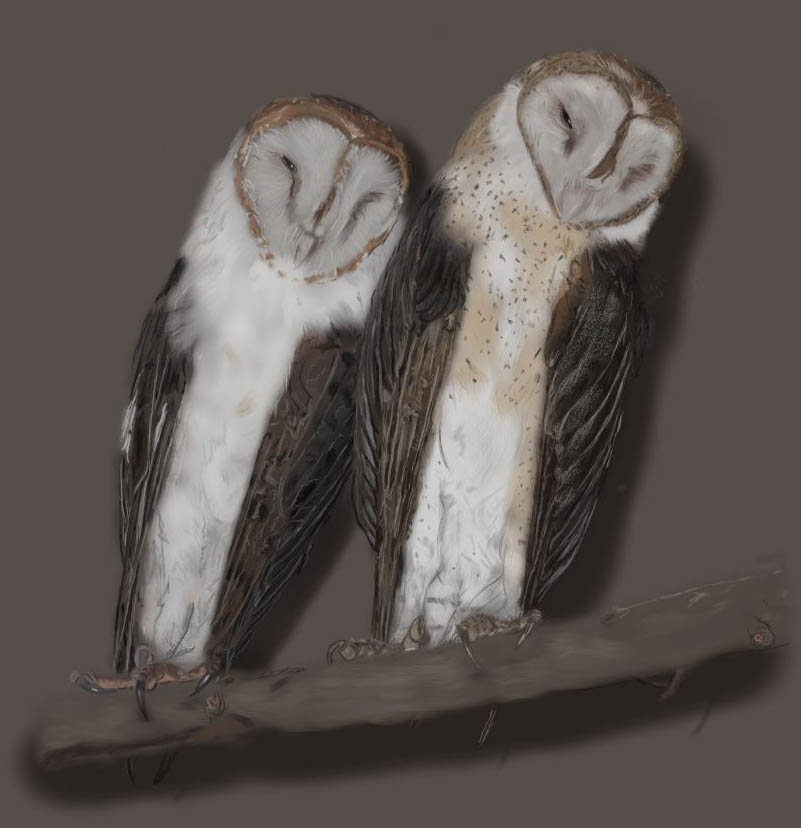Inventory of owls in northern Mesoamerica (Mexico, Belize, Guatemala)
Owls are prominent in the Maya sacred book of the Popol Vuh. If you scrutinized dozens of other Maya ethnographic and ethnohistorical accounts surely owls would also show up.
Owls are beautifully presented in Classic Maya art, and especially in the art of Teotihuacan in Central Mexico.
Electronic rendering of Pulsaterix perspicillata saturata, spectacled owl, búho de anteojos, on a Wacom Intuos by Melanny Quiñonez, copyright FLAAR 2014, based on photography by Nicholas Hellmuth, courtesy of access into the owl precinct of La Aurora Zoo, the leading zoological research park in Guatemala City.
Electronic rendering of Tyto alba, Grass owl, Lechuza de campanaria, on a Wacom Intuos by Melanny Quiñonez, copyright FLAAR 2014, based on photography by Nicholas Hellmuth, courtesy of access into the owl precinct of La Aurora Zoo, the leading zoological research park in Guatemala City.
If you inventoried every bird that was pictured or described in Mayan hieroglyphs you would certainly eventually come across owls.
Owls are magestic creatures of nature: beautiful, mysterious, and wonderful to see face-to-face.
I must admit that I had a pet owl; no cage: it was free to fly anywhere in our facilities. I found it on the street as I was en route to speak with the Vice President in his office. During the years with this owl I can say that most of the popular beliefs about owls are a bit delusional. But this page is not to describe owl behavior but to list the species which are available to study.
- A web site on birding of Chichen Itza lists four owls.
- The book on birds of Chiapas shows paintings of 18 owls.
- My tabulation below listed 29 owls in our first edition.
- After checking the list of Wikipedia, our combined list was about 36 owl species (so my list had some missing in theirs; and their list had some missing in mine). This is largely because I list for the whole Maya area (Guatemala, Belize, parts of El Salvador, parts of Honduras, and about half of Mexico).
So I would estimate that between 30 and 40 owls inhabit Mesoamerica if you include the areas occupied and influenced by Teotihuacan (namely Central Mexico, Veracruz, Oaxaca) in addition to the areas occupied and influenced by the Maya (which would imply parts of Honduras and El Salvador).
The owl species in bold font are listed in the book on birds of Chiapas (Alvarez del Toro 1980 Plates 34 and 35).
The owl species in red color are listed by Wikipedia for their list of birds of Guatemala http://en.wikipedia.org/wiki/List_of_birds_of_Guatemala
So an owl in red bold font means it is listed in Wikipedia and also in Birds of Chiapas.
We hope to list names in K’ekchi’ (Q’eqchi’), and other Mayan languages as soon as funding makes it possible to have a linguist on-staff in-house.
Next step is to indicate which of these owls are available to study in the La Aurora Zoo, Guatemala City and/or in other zoos or private collections in Guatemala. Yes, its great to get outside in the forests and study birds in their natural habitat, but most of the habitat is being destroyed daily (half is totally obliterated already). Plus it would take weeks to find pertinent species, not to mention the travel time and logistics. Plus photography in the forests, at night, is a tad unrealistic for many parts of the world (unless funding provided for the team, security, and all the other things needed to have a team in a dozen different eco-systems).
Stygian owl (Asio stygius) Photographed by Nicholas Hellmuth
In the meantime, this list is intended to remind us of the sheer quantity of owl species in northern Mesoamerica.
| Scientific name | English | Spanish | Yucatec_Maya |
|---|
| Aegolius acadicus | ||||
| Aegolius ridgwayi | Unspotted Saw-whet Owl | |||
| Asio flammeus | Short-eared owl | |||
| Asio otus | ||||
| Asio stygius | Stygian owl | |||
| Athene cunicularia | Burrowing owl | |||
| Bubo virginianus mayensis | Great Horned owl | búho real | Moan Ikim | Can even live in caves |
| Ciccaba nigrolineata | Black-wnd-White Owl | |||
| Ciccaba virgata, Strix virgata | Mottled owl | |||
| Glaucidium brasilianum ridwayi | Ferruginous pygmy owl | Buho Viejita or Mochuelo Caburé | X'nuk | |
| Glaucidium gnoma | Northern Pygmy-Owl | |||
| Glaucidium griseiceps | Central American pigmy owl | |||
| Glaucidium minutissimum | ||||
| Glaucidium sanchezi | Tamaulipas Pygmy Owl | |||
| Lophostrix cristata | Crested Owl | |||
| Megascops kennicottii | Western Screech owl | Wikipedia only | ||
| Megascops cooperi | Pacific screech owl | Wikipedia only | ||
| Megascops trichopsis | Bearded screech owl | Wikipedia only | ||
| Megascops barbarus | Vermiculated screech owl | Wikipedia only | ||
| Micrathene whitneyu | ||||
| Otus asio | ||||
| Otus atricapillus | ||||
| Otus barbarus | ||||
| Otus cooperi | ||||
| Otus flammeolus | Flammulated owl | |||
| Otus guatemalae | ||||
| Otus kennicottii | Western screech owl | |||
| Otus trichopsis | ||||
| Pseudoscops clamator | Striped owl | |||
| Pulsatrix perspicillata | Spectacled Owl | |||
| Rhinoptynx clamator | ||||
| GSpeotyto cunicularia | Burrowing owl | Also see Athene cuniculari | ||
| Strix fulvescens | Fulvous Owl | |||
| Strix occidentalis | Mexican Spotted Owl | |||
| Strix varia | More Mexico and northward | |||
| Tyto alba | Barn owl | lechuza común | Xoch' | Distinctive face, all one color face |
Otus asio is divided up in so many regional species (Peterson and Chalif 1999:82) it is not easy to keep track.
Our bibliography on owls will be placed on our bibliography web site: www.maya-art-books.org.
First posted June 3, 2014.


























